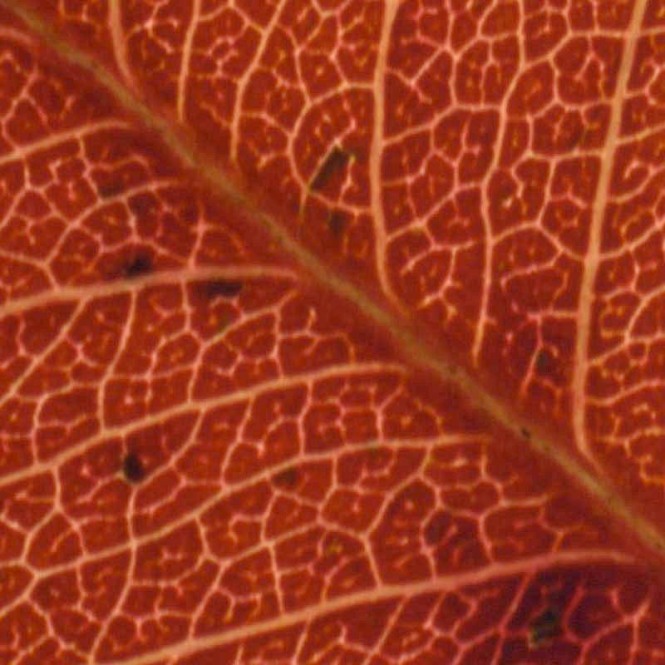Fellow bloggers Steve and Steve often include beautiful close-up photos of leaves in their posts. They inspired me to try imaging leaves in a different way. I decided to use a flatbed scanner. During a recent walk, I picked up three examples that were colorful and still in good shape. I got a pin oak, maple, and ornamental pear and headed home.
First up on the scanner was the oak leaf. I placed it face down on the glass and set the resolution to a high value of 800 dpi. I wanted to get lots of detail in the scanned image.
That turned out pretty nice showing the leaf vein structure and cells. Next up was the maple.
Each image above was made by reflecting light off of the surface of the leaf. My scanner can also image 35 mm slides. That process requires the use of a light source in the lid of the scanner so it can project through the color transparency film of a slide. The maple and the pear leaves were thin enough to allow a large amount of light to pass through them much like a 35 mm slide. I figured it was worth trying to scan them using the slide setting. First, I did the maple leaf on the 800 dpi transmission setting.
That turned out better than I expected. There was more detail revealed than the reflection setting. The image above is a 1 inch square area. I tried higher resolutions of 1200 and 2400 dpi of the same part of the leaf? The next images are of areas 2/3 and 1/3 inches square.
Not much detail was gained by the 2400 dpi setting. It did render a much larger and slower scan. I had one more leaf to try, the pear. Both images below used the slide transmission setting. The leaf detail is quite different from the oak and the maple.
That was fun to view the autumn leaves in a different way. I’m beginning to think of other transparent objects or things in nature that might be interesting to view this way. Do you have some ideas to share?








What brand and model of scanner do you have? Mine needs to be updated.
It’s an Epson 1650, but several years old. I rarely use it. Most of my scanning is on a Brother laser printer, scanner, copier. It serves most of my needs.
Find some bird feathers or insect wings.
Those are good ideas. I will add them to the list. Thanks. Good to see you here.
[…] images of leaves using a flatbed scanner set to reflection and transmission modes for comparison. See those here. This post includes scans of a variety of common objects. My favorite is the back of the Lincoln […]
Have not done this, so I don’t know, but I really like it for the detail.
The maple’s color is lovely, but for some reason, I favor the pear. Maybe it is the different pattern. It’s an interesting approach to seeing objects in a new way. I think feathers would be interesting. Also, if you’d like to try a monarch butterfly wing, I have one I can send you. 🙂
We went for a long walk the morning before I scanned these. I kept looking for a bird feather. None were to be found.
As to the wing…thanks for the offer.
I haven’t done anything with leaves on scanners, but out in nature I generally get more impressive pictures with backlighting (transmission) than with front lighting (reflection), although sometimes reflection has worked well too.
It is fun to see them this way. I never much liked looking in a microscope, which is too bad because really, it is a fascinating world and your scanner reminded me of that.
I’ve just realized your posts have not been landing in my inbox for some reason, so I’ve clicked the button again. Hopefully I’ll get them now!
I hope that fixes it. Or, maybe you can follow via email instead of Reader.